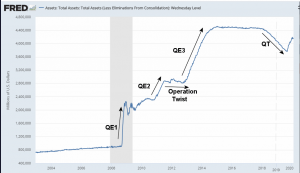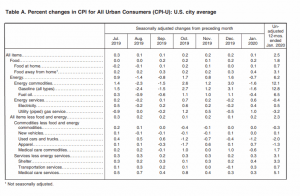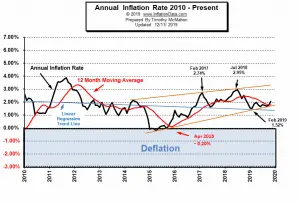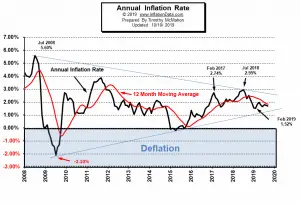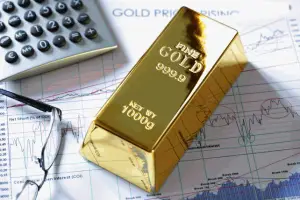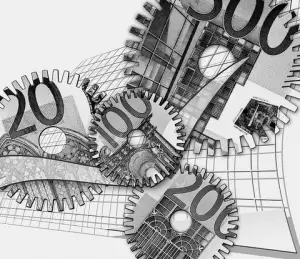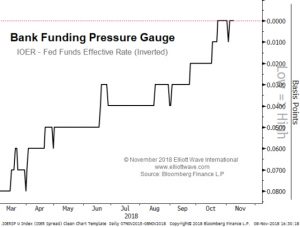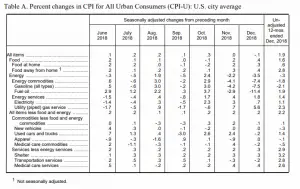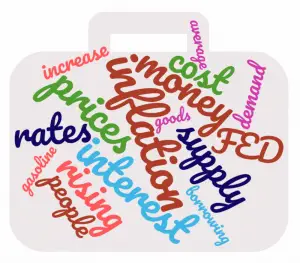When the government spends more money than it receives in taxes it has a “deficit” situation. In order to deal with this deficit, it engages in some fancy bookkeeping. The government is made up of a variety of agencies, so the other agencies request money from the Treasury Department. If it doesn’t have enough money the Treasury Department issues an IOU (called a Government Bond). The Treasury gives the Bond to the Federal Reserve (which is theoretically not part of the government). The FED writes a check to the Treasury for the bond. It then breaks up the bond into smaller bonds and sells them to individual banks. The banks then sell them to individual investors and groups of … [Read more...]
January Inflation Spikes to 2.49%
The U.S. Bureau of Labor Statistics (BLS) released its January Inflation report on February 13th, 2020, for the 12 months through the end of January 2020. Annual Inflation Jumps Up Again Annual inflation tops the 2019 high set in December at 2.29% reaching 2.49% in January. CPI Index in January was up almost 1 point to 257.971, December was 256.974, November was 257.208 down from October's 257.346 Monthly Inflation for January was 0.39%, December was -0.09% up from 0.19% in January 2019. Next release March 11th Annual inflation for the 12 months ending in January was up to 2.49%. Annual inflation in December was 2.29%. The CPI index itself rose almost exactly a full … [Read more...]
November Annual Inflation Jumps Up But…
The U.S. Bureau of Labor Statistics (BLS) released its November Inflation report on December 11th, 2019, for the 12 months through the end of November 2019. November Inflation is Up Annual inflation in November was 2.05% up from October's 1.76%. The last time inflation was this high was in April. Inflation has been in a narrow range through much of 2019. 1.79% in May, 1.81% in July, 1.65% in June, with a high of 2.00% in April. Inflation peaked at 2.95% in July 2018. The CPI-U index in November was 257.208 down from 257.346 Monthly Inflation for November was -0.05% much higher than -0.33% in November 2018. Next release January 14th The CPI index itself actually … [Read more...]
October Inflation has Slight Increase
The U.S. Bureau of Labor Statistics (BLS) released its October Inflation report on November 13th, 2019, for the 12 months through the end of October 2019. Annual Inflation is Up Very Slightly Annual inflation in October was 1.76% up from September's 1.71% and still virtually unchanged from August's 1.75%. Inflation has been in a narrow range throughout 2019. 1.79% in May, 1.81% in July, 1.65% in June, with a high of 2.00% in April. Inflation peaked at 2.95% in July 2018. The CPI-U index in October was 257.346 Monthly Inflation for October was 0.23%, September was 0.08%, August was -0.01%, July was 0.17%, June was virtually zero at 0.02%, May was 0.21%, April was … [Read more...]
September Inflation Virtually Unchanged
The U.S. Bureau of Labor Statistics (BLS) released its September Inflation report on October 10th, 2019, for the 12 months through the end of September 2019. Annual Inflation is Down Very Slightly Annual inflation in September was 1.71% virtually unchanged from August's 1.75%. Inflation has been in a narrow range throughout 2019. 1.79% in May, 1.81% in July, 1.65% in June, peaking at 2.00% in April. Inflation peaked at 2.95% in July 2018. The CPI-U index in September was 256.759 up from 256.558 in August. Monthly Inflation for September was 0.08%, August was -0.01%, July was 0.17%, June was virtually zero at 0.02%, May was 0.21%, April was 0.53%, March was 0.56%. … [Read more...]
Gold Price and Its Relationship with Inflation
Inflation is the increase in the price you pay for goods and services, which affects the purchasing power of your money. This is more accurately called "price inflation" as compared to "monetary inflation". As inflation increases, the value of your money decreases. There are many different causes of inflation, but the most important cause is an increase in a country’s money supply. When the government decides to print money or implement a quantitative easing program, the money supply is increased (i.e. monetary inflation), thus affecting the general level of prices. As we can see in the following chart, the Federal Reserve engaged in three phases of quantitative easing i.e. QE1, QE2, … [Read more...]
How Does Inflation Affect Foreign Exchange Rates
Inflation affects every consumer, business person and investor in some way or other. Inflation is one of the key factors that affect consumer prices, financial markets including Stocks, Bonds and Forex. As such, it is important for consumers, investors and traders to get a deeper understanding of what is inflation and what causes it. What is Inflation? Understanding inflation is often complicated by the fact that the cause and the effect are often muddled together in people's minds due to the lazy way we often refer to inflation. The effect of inflation is what people see when they go shopping and see increases in the general price of goods and services. When the individual prices of just … [Read more...]
Are Deflationary Forces Taking Hold Again?
From the chart below we can see that deflation was an issue in 2009 as the market eliminated billions of dollars in assets when it crashed. The FED used all the tricks in the book to combat the contraction of the money supply including lowering interest rates to near zero and when that wasn't enough it began buying assets through its "quantitative easing" (QE) programs. But the deflationary forces weren't through yet and by 2015 the FED was once again battling deflation. In the chart below we can see that after dropping interest rates to almost zero they kept them there until 2016 when they increased rates very tentatively. But in 2017 they began raising rates a bit more … [Read more...]
2018 Ends with More Disinflation
The U.S. Bureau of Labor Statistics (BLS) released their monthly Consumer Price Index report on January 11th 2019, for January 1 through December 31, 2018. Annual Inflation is Down Annual inflation in December was 1.91% down from November's 2.18%. December's CPI was 251.233 which was below November's 252.038, below October, September and even below the 251.588 in May. Monthly Inflation for December was -0.32% virtually identical to November's -0.33%. Next release February 13th Monthly Inflation: According to the BLS commissioner's report, "In December, the Consumer Price Index for All Urban Consumers fell 0.1 percent on a seasonally adjusted basis; rising 1.9 percent over … [Read more...]
How Inflation and Interest Rates Relate
In addition to sounding similar interest and inflation are amazingly inter-related. And in effect interest rates incorporate a "negative feedback loop" into inflation. When people think of the word inflation they generally think of how inflation affects them. They see rising prices of common commodities like gasoline or food and worry about the rising cost of living. But that is simply the effect of inflation and it is technically referred to as "price inflation" but the cause of price inflation itself is actually much more complicated. In the short run, prices can rise due to a shortage in supply, such as a gasoline shortage caused by a refinery having to shut down due to a … [Read more...]

